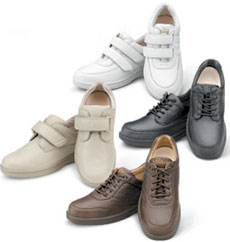What diabetes shoes different?
Shoes for diabetics tend to give more space for foot orthoses and a normal shoe. diabetes shoes are usually wider and deeper than most other shoes and have comfortable shoes.
In most cases, diabetic shoes custom-made to ensure that the shoe, the weight evenly distributed and fits exact. After a custom boot can prevent friction, the friction and the loss of pedestrian traffic, which can not be a person with a notice of diabetes due to loss of sensation in the foot.
In addition to the specialized, designed for diabetics, diabetes, diabetic shoes and sandals must be made even more breathable fibers such as cloth or transfer so that the foot traffic from the air healthy. Good air circulation helps the skin to breathe, to prevent pressure ulcers and increased blood flow helps.

Diabetic Shoes

Diabetic Shoes

Diabetic Shoes
What makes a good pair of shoes from diabetes
• Make sure the materials to "breathe," such as canvas or sandals. respirable fibers prevent the foot from sweating, swelling, and friction.
• Shoes must be deep enough to accommodate an insert foot and wide enough to avoid kinking.
• Avoid shoes that rub against the stitching step and may cause skin irritation.
• The area of convergence in front of the shoe should be large enough so to move your toes.
• resilient in shoes can also help to prevent slipping the shoe on the foot keeping it comfortably in place.
People with diabetes are more prone to pain due to an increased risk of damage to nerves and blood vessels. You can help prevent these problems with the following tips:
• Wash your feet in warm water with a mild soap every day, but not soaked. Dry thoroughly, especially between the toes.
• Check your feet daily for cuts, sores, blisters, redness, hardening or other problems. Call your doctor if healing does not start after one day.
• If your skin is dry, rub lotion on his feet after you wash and dry. Do not put lotion between your toes.
• care file corns and calluses with a pumice stone or Schmirgelstab (the move in one direction). To do this, after a bath or shower when skin is soft.
• Cut the nails once a week or as needed. Cut with a nail clipper straight and then the edges with a nail file. If you can not see or reach them, ask a family member or doctor to help the team.
• Always wear shoes or slippers to protect feet from injury. Do not wear sandals or go barefoot, even around the house.
• Always wear socks or stockings to avoid blisters. Choose a pair that fits your feet soft and supple.
Shoes for diabetics tend to give more space for foot orthoses and a normal shoe. diabetes shoes are usually wider and deeper than most other shoes and have comfortable shoes.
In most cases, diabetic shoes custom-made to ensure that the shoe, the weight evenly distributed and fits exact. After a custom boot can prevent friction, the friction and the loss of pedestrian traffic, which can not be a person with a notice of diabetes due to loss of sensation in the foot.
In addition to the specialized, designed for diabetics, diabetes, diabetic shoes and sandals must be made even more breathable fibers such as cloth or transfer so that the foot traffic from the air healthy. Good air circulation helps the skin to breathe, to prevent pressure ulcers and increased blood flow helps.



What makes a good pair of shoes from diabetes
• Make sure the materials to "breathe," such as canvas or sandals. respirable fibers prevent the foot from sweating, swelling, and friction.
• Shoes must be deep enough to accommodate an insert foot and wide enough to avoid kinking.
• Avoid shoes that rub against the stitching step and may cause skin irritation.
• The area of convergence in front of the shoe should be large enough so to move your toes.
• resilient in shoes can also help to prevent slipping the shoe on the foot keeping it comfortably in place.
People with diabetes are more prone to pain due to an increased risk of damage to nerves and blood vessels. You can help prevent these problems with the following tips:
• Wash your feet in warm water with a mild soap every day, but not soaked. Dry thoroughly, especially between the toes.
• Check your feet daily for cuts, sores, blisters, redness, hardening or other problems. Call your doctor if healing does not start after one day.
• If your skin is dry, rub lotion on his feet after you wash and dry. Do not put lotion between your toes.
• care file corns and calluses with a pumice stone or Schmirgelstab (the move in one direction). To do this, after a bath or shower when skin is soft.
• Cut the nails once a week or as needed. Cut with a nail clipper straight and then the edges with a nail file. If you can not see or reach them, ask a family member or doctor to help the team.
• Always wear shoes or slippers to protect feet from injury. Do not wear sandals or go barefoot, even around the house.
• Always wear socks or stockings to avoid blisters. Choose a pair that fits your feet soft and supple.